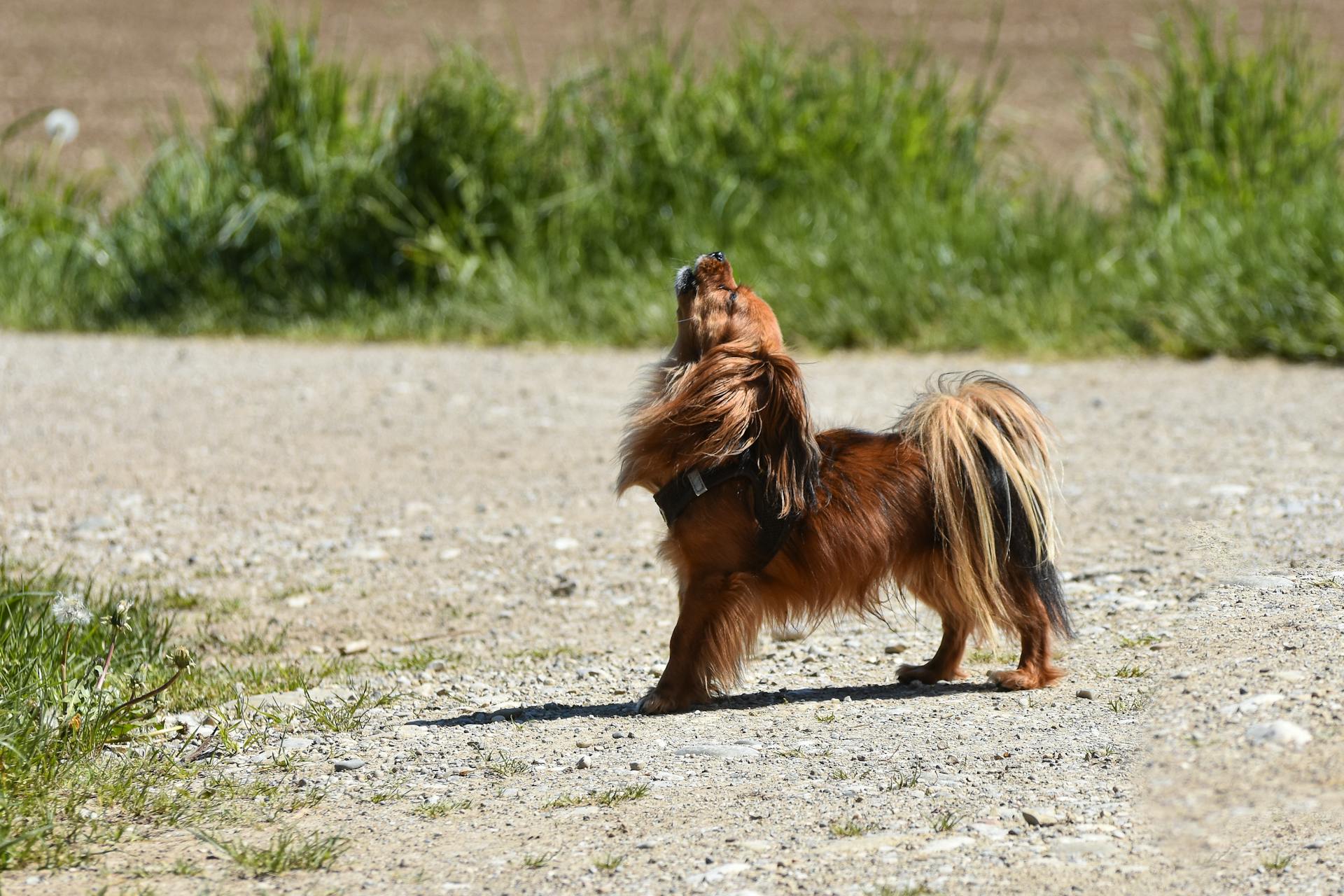
The Basenji, known for its unique yodeling howl, is a breed that's often misunderstood. Originally from central Africa, they were bred to hunt small game.
Their short coats and athletic build make them well-suited for hunting in dense terrain. The Basenji's independence and strong prey drive require experienced handlers.
Their hunting style is often described as "stalk-and-bay", where they'll creep up on prey and then let out a loud, high-pitched call to flush it out.
See what others are reading: Do German Shepherds Have High Prey Drive
Basenji Hunting Essentials
Basenjis have been used as hunting dogs since ancient times, with archaeological evidence dating back to 3500 B.C. showing their use in Egypt and other African countries.
Their natural instincts make them well-suited for hunting small animals like squirrels, rats, mice, and birds. They hunt silently, by scent and sight, stalking their prey until close enough to make the kill.
The Basenji's barkless nature is a key advantage for hunters who want the element of surprise. This trait, combined with their ability to trail game, makes them a top choice for hunting.
They can hunt all day without tiring, and are often called independent or stubborn dogs due to their ability to work alone without supervision. This can be frustrating for owners who are used to dogs that are always attentive and obedient.
Worth a look: Dogs Breeds That Start with B
Unique Characteristics
The Basenji's unique characteristics make them a fascinating breed to hunt with. Their independence and strong prey drive are key factors in their success as hunting companions.
Their short coats and athletic build enable them to navigate dense underbrush with ease. This allows them to track and flush out small game, such as rabbits and hares, with precision.
They're Dogs
Basenjis are skilled hunting dogs, developed with a focus on intelligence, courage, and adaptability. These traits allowed them to excel in the field, often working out of sight of the hunters.
They're highly intelligent dogs, capable of problem-solving and quick thinking.
They Don’t Bark
The Basenji's unique vocalization is one of its most distinctive characteristics. They can't bark like most other dogs, which might seem strange at first.
The reason for this is that the Basenji's larynx is shaped differently. This shape prevents them from producing the same sound as other dogs.
As a result, the Basenji will often growl or make a yodeling sound instead. These vocalizations are usually short and not very loud.
The African tribes who use Basenjis as hunting dogs have found a clever solution to track their prey. They tie bells around the Basenjis, so the hunters can follow the sound of the bells as they track their quarry.
Check this out: Beagle Bark Sound
Basenji History and Lineage
The Basenji has a rich history that's as fascinating as it is complex. The breed originated on the continent of Africa, where Europeans first described it in 1895 in the Congo.
Prized by locals for their intelligence, courage, speed, and silence, the Basenji was initially difficult to introduce to England due to disease. Several attempts were made, but it wasn't until the 1930s that foundation stock was successfully established in England, and then in the United States.
The Basenji's lineage is also quite interesting - DNA studies indicate that the breed predates the emergence of modern breeds in the 19th century.
For another approach, see: English Cocker Spaniel Breeders New England
Lineage
The Basenji's lineage is a fascinating topic. The breed has been identified as a basal breed that predates the emergence of modern breeds in the 19th century.
The Basenji and dingo are both considered to be basal members of the domestic dog clade, according to DNA studies. This means they share a common ancestor with other dogs, but one that lived before the modern breeds we know today.
The Basenji's genome has been assembled, and it shows that the breed falls within the Asian spitz group. This group includes other breeds like the husky and wolf.
The Basenji possesses only two copies of the AMY2B gene, which produces an enzyme that helps digest starch. This is similar to the wolf, husky, and dingo, which also have only two copies of this gene.
These findings suggest that the Basenji, like the dingo and other ancient breeds, arose before the expansion of agriculture.
Broaden your view: German Shorthaired Pointer Group
History
The Basenji originated on the continent of Africa, where locals prized them for their intelligence, courage, speed, and silence.
The first European descriptions of the breed date back to 1895 in the Congo.
Several attempts were made to introduce the breed into England, but they all failed due to disease.
It wasn't until the 1930s that foundation stock was successfully established in England, and then in the United States by animal importer Henry Trefflich.
The breed was officially accepted into the AKC in 1943, and nearly all the Basenjis in the Western world are descended from the original imports.
In 1990, the AKC stud book was reopened to 14 new imports at the request of the Basenji Club of America.
An American-led expedition collected breeding stock in villages in the Basankusu area of the Democratic Republic of Congo in 2010.
Basenjis are also registered with the United Kennel Club.
Expand your knowledge: New England Bulldog Breed
Frequently Asked Questions
What are Basenji dogs used for?
Basenjis are primarily family pets, valued for their loyalty and affection towards their owners. They are not typically used for hunting, but excel as loving companions.
What are the disadvantages of a Basenji?
Basenjis may exhibit dominant behavior towards other dogs and strong prey drive, posing a risk to smaller pets and other animals
Featured Images: pexels.com


